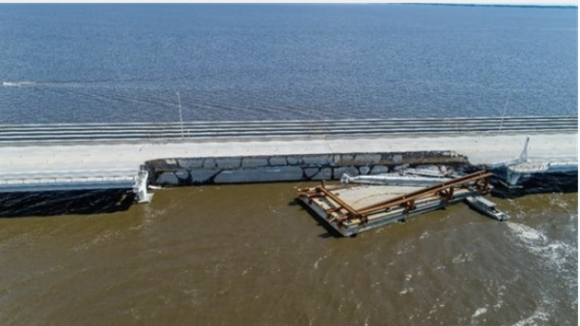A construction company whose barges came loose from their moorings during Hurricane Sally and damaged the Pensacola Bay Bridge will have to cope with some 900 claims by businesses and other parties that say they suffered economic damages while the bridge was closed for repairs.
A panel of the 11th Circuit Court of Appeals on Wednesday rejected arguments by Skanska USA that the Limitations Act — a law passed by Congress in 1851 — required a district court to determine whether it was liable for each of the claims against it before deciding whether its liability should be limited or even exonerated.
“Skanska’s approach would turn the Limitation Act on its head, and our precedents have already rejected it,” the panel’s opinion says. “We have been clear that the purpose of the Act is limitation, not exoneration.”
The Bay Bridge, first built in the 1930s, is the main thoroughfare that connects Pensacola to its beaches and the communities adjoining them. Skanska was awarded a contract to replace the old three-mile span with a more modern bridge and remove the old one. The construction company had opened four lanes of the new bridge in September 2020, when Hurricane Sally approached from the south.
Skanska had a hurricane-preparation plan that called for it to move its 55 construction barges to Butcherpen Cove on the south side of the bay during storm events. That process was expected to take about 30 hours.
Initial forecasts made when Sally was still a tropical depression had the storm making landfall to the west of Pensacola, near the Mississippi and Louisiana border. Skanska executives decided to wait and see.
Three days before landfall, however, the National Hurricane Center issued a revised forecast that gave the storm a 16% chance of striking the Pensacola area. Skanska began moving its barges, but instead of pulling them all the way to Butcherpen Cove, the company tied them down to pipe pilings that crossed the bay, generally within 500 feet of the new bridge.
Sally came ashore with winds over Pensacola Bay ranging from 47 to 74 mph and gusts as high as 92 mph. During the storm, 28 of Skanska’s construction barges broke loose. Some of them slammed into the bridge and others smashed into property along the edge of the bay. The collisions forced closure of the bridge for more than eight months.
Lawsuits against Skanska began piling up. Parties including Bagelheads Inc., McGuire’s Irish Pub and the city of Gulf Breeze claimed damages. A total of 1,000 claimants joined proceedings against Skanska, 900 of them claiming economic damages because of the bridge’s long closure.
Skanska filed petitions under the Limitations Act, which cap damages against the owners of maritime vessels to the value of the vessels and cargo unless the owner’s negligence caused the damage. A judge with the US District Court for Northern Florida, however, ruled that Skanska was negligent, so the Limitations Act offered no protection.
Skanska appealed. The company did not dispute the finding that it was negligent, but argued that the Limitations Act required the district court to decide whether it was liable to each and every claimant before determining whether the liability should be limited. The company also argued that under Supplemental Rule F of the Limitations Act, it could ask for exoneration.
The 11th Circuit said the Limitations Act is a “difficult law,” written at a time with different economic realities, and also “badly drafted even by the standards at the time,” according to one court decision. The law was adopted with no procedures to implement it, so the courts promulgated their own rules over time.
The body of law that developed typically requires a two-step procedure. First, the court must determine what acts of negligence or conditions of unseaworthiness caused an accident. Second, the court must determine whether the ship owner had “knowledge or privity” of the negligent acts or unseaworthiness.
The appellate panel said it has rejected any “rigid reliance” on procedure in past decisions regarding the Limitations Act. In Skanska’s case, the panel said, there was no need to determine which claims should be limited after the district court ruled that the company’s decision not to move its barges caused the damage.
Additionally, the panel said Supplemental Rule F was added to the Act not to offer a means of seeking exoneration, but to make it clear that an American maritime vessel owner, unlike those governed by old English law, is not required to admit liability for an accident to seek limits on its liability.
“Yes, Skanska had the right to have the question of limitation adjudicated in federal court,” the opinion says. “And the question of limitation was adjudicated in federal court. But that is as far as it goes.”
Attorney Brian Barr with Levin Papantonio Rafferty was among the attorneys who represented Bagelheads and other claimants on appeal. He said in an email that the appellate panel followed clear precedent.
“Limitation was never possible for Skanska as their executives on site were the people that made the negligent decisions,” he said. “Their right to seek limitation was fully protected. They just failed to meet their burden.”
Top photo: A section of the Pensacola Bay bridge that was damaged by the barge. The damage forced the bridge to close for months, disrupting life and business in Pensacola and Gulf Breeze, Florida. Courtesy, City of Pensacola.
Was this article valuable?
Here are more articles you may enjoy.


 Palantir Poaching Suit Called ‘Scare’ Tactic by Ex-Employees
Palantir Poaching Suit Called ‘Scare’ Tactic by Ex-Employees  California Governor Seeks $200M to Replace EV Tax Credits Cut by Trump
California Governor Seeks $200M to Replace EV Tax Credits Cut by Trump  Tesla, EEOC Plan Talks to Settle Factory Racism Suit
Tesla, EEOC Plan Talks to Settle Factory Racism Suit  Insurance Payments Now at $22.4B From LA Wildfires One Year Ago
Insurance Payments Now at $22.4B From LA Wildfires One Year Ago 